Article's Content
Pop Quiz:
Which B2B SaaS company is a crucial operational component for massive players like Morgan Stanley, Barclays, Cisco, IBM, and tens of thousands of others?
If you’re like me, there’s a short list of names that immediately come to mind: Amazon Web Services (AWS), Google, and Microsoft.
While these titans are unquestionably critical to our digital economy, they share another thing in common — reliance on this particular unicorn. In fact, said unicorn is so disruptive that it’s forcing institutional competitors like Amazon and Google to rely on them as partners (but more on that later).
Enter MongoDB — the application data platform.

MongoDB has experienced immense growth since its 2016 IPO — despite being up against giants like AWS, Google, Microsoft, IBM, and Oracle. And there’s a reason for this.
Throughout today’s teardown, I want you to keep this sentiment from Malcom Gladwell in mind:
“Giants are not what we think they are. The same qualities that appear to give them strength are often the sources of great weakness.”
Capitalizing on the Cloud-Computing Boom
Before we dive into the marketing prowess of MongoDB, it’s important to understand the dynamics behind the current cloud computing market. The cloud-infrastructure boom is in full swing. More and more companies are looking to move from physical or legacy services to the cutting edge of cloud computing — and they’re spending serious money.
How much money, you ask? According to Gartner: $1.3 trillion dollars in 2022.
Software-, platform-, and infrastructure-as-a-service offerings are all essential parts of enterprise operations. Companies are more and more distributed, meaning on-site servers just don’t cut it anymore. You can’t win the digital space race with dial-up internet. It’s just not competitive.
And with cloud computing comes the need for observability tools and an equally agile cloud database. A small but rapidly growing chunk of that Cloud IT spend involves the management of unstructured data — the qualitative information that legacy data-handling methods can’t handle.
This includes:
- Text, audio, and video files
- Data from sensors and recording devices
- Mobile phone usage
- Social media posts
- Geo-tagging
This information doesn’t receive the same level of attention as structured data like customer profiles and payment information, but it’s now coming to a head. Experts believe that by 2025, 80% of all enterprise data will be unstructured. And unstructured definitely doesn’t mean unimportant.
With the proper tools and expertise, these lakes of unstructured data become a rich well of behavioral insight on consumers and internal operations. But that’s putting the cart before the horse. First, you need a database equipped to handle this ever-growing body of data. This is where MongoDB’s perfect market position comes into play.
Product-Led Growth, Product Marketing, and The Atlas Effect
Product excellence is undoubtedly a crucial component to success in the B2B SaaS space — particularly when it comes to unicorns like MongoDB. How else can you explain their success despite being outgunned by the likes of the companies listed below:
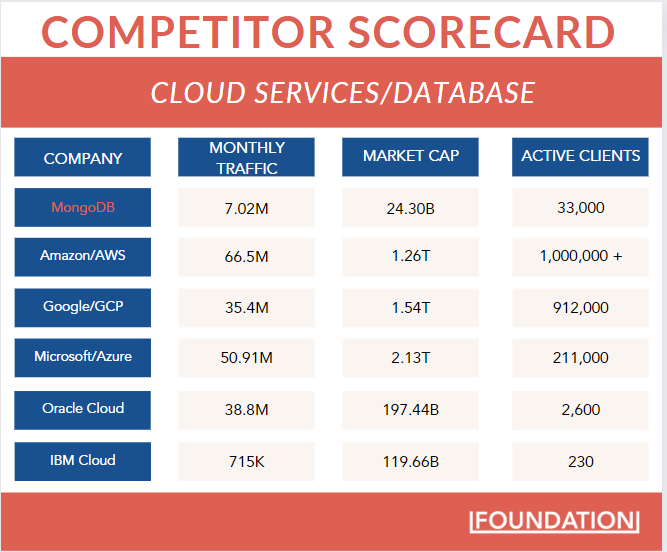
Whichever way you cut it — web traffic, market cap, or workforce — it appears that MongoDB is fighting a losing battle. It’s David vs. Goliaths.
But it turns out being David is not such a bad thing when you’re fighting in the realm of giants. Remember Gladwell’s words: their strengths are often the source of their weakness. While these massive companies are busy duking it out with each other over market share, commoditizing as many services as they possibly can along the way, MongoDB is zeroing in on their key value proposition: database management.
No balancing database R&D spend with retail networks or advertising platforms. No more laying back on outdated legacy achievements. (Sorry, Oracle. Fifty years was a good run, though.)
MongoDB prioritizes being a developer-friendly database built to scale alongside growing companies to handle their ever-growing icebergs of unstructured data. Since their founding in the mid-2000s, they have been perfecting their craft, gaining the attention and trust of the developers who are now so crucial to the operations of our digital society.
Then, this 21st-century David dropped their ultimate giant-killer.
MongoDB Atlas — Database-as-a-service.
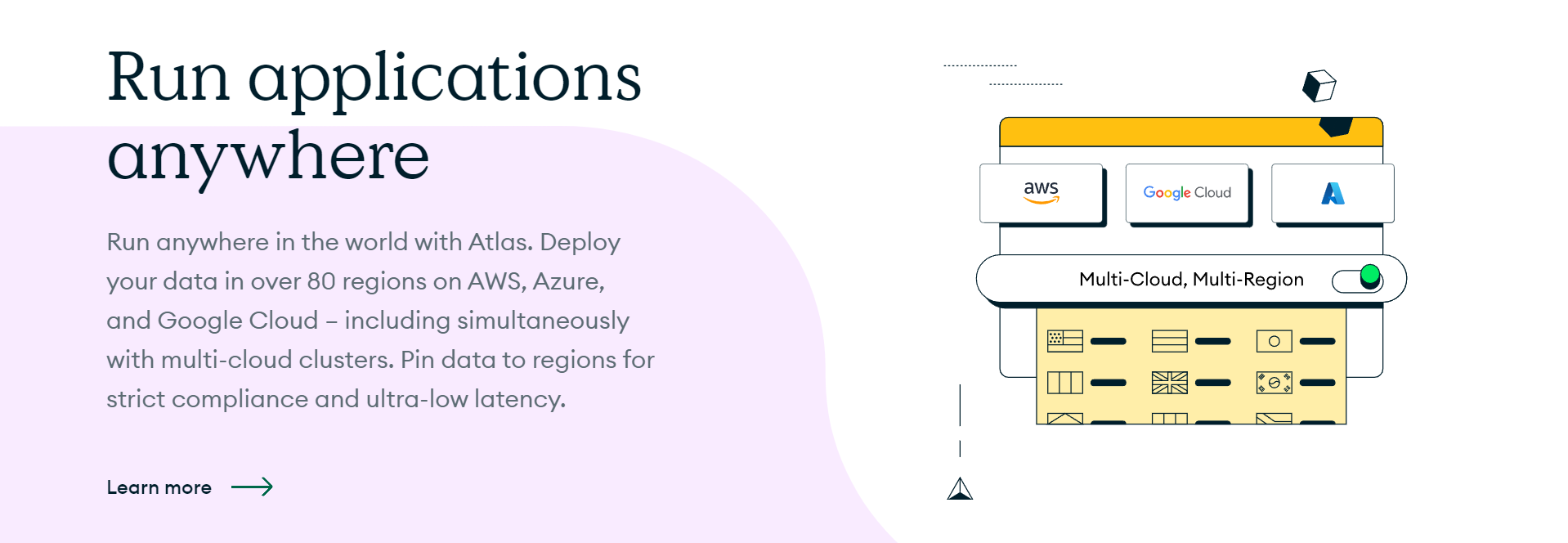
This paid service is MongoDB’s cash cow. First rolled out in 2016, just a year before its IPO, Atlas has been driving the company’s revenue ever since. Here are a few of the highlights:
- 85% revenue growth in Q4 2022
- Annualized revenue of over $1 billion
- 0ver 80% growth in deals from cloud vendor partners
This last point is important — it turns out the Goliaths are scared of David. Google and Amazon are both opting to “join ‘em” since they clearly can’t “beat ‘em.” (At least, not at the moment.) The cloud services arms of these companies now use MongoDB’s DaaS offering as a tool to get growing startups on AWS and Google Cloud.
Want to increase online interactions with customers by up to 40%? 💬
Learn how @GoogleCloud and MongoDB helped Lucky Cart do just that with data-driven gamification. 📉https://t.co/8Ro5n9dZ3x
— MongoDB (@MongoDB) April 29, 2022
As a result, MongoDB can now leverage the reach and authority of two of the biggest names — not just in tech, but across all industries.
Powering SEO Success by Embracing the Technical
As important as a great product is to success, it can only take you so far. Lots of marketers roll their eyes when you bring up marketing metrics like organic traffic and keyword ranking, but it’s fundamental to marketing success. Everyone overlooks fundamentals when you make it to the big leagues, but that doesn’t negate the fact that that’s a big part of what gets you there. And MongoDB has definitely reached pro status. Every month, nearly 20 million people visit their site.
This is even more impressive when you consider that two channels drive the majority of their web traffic:
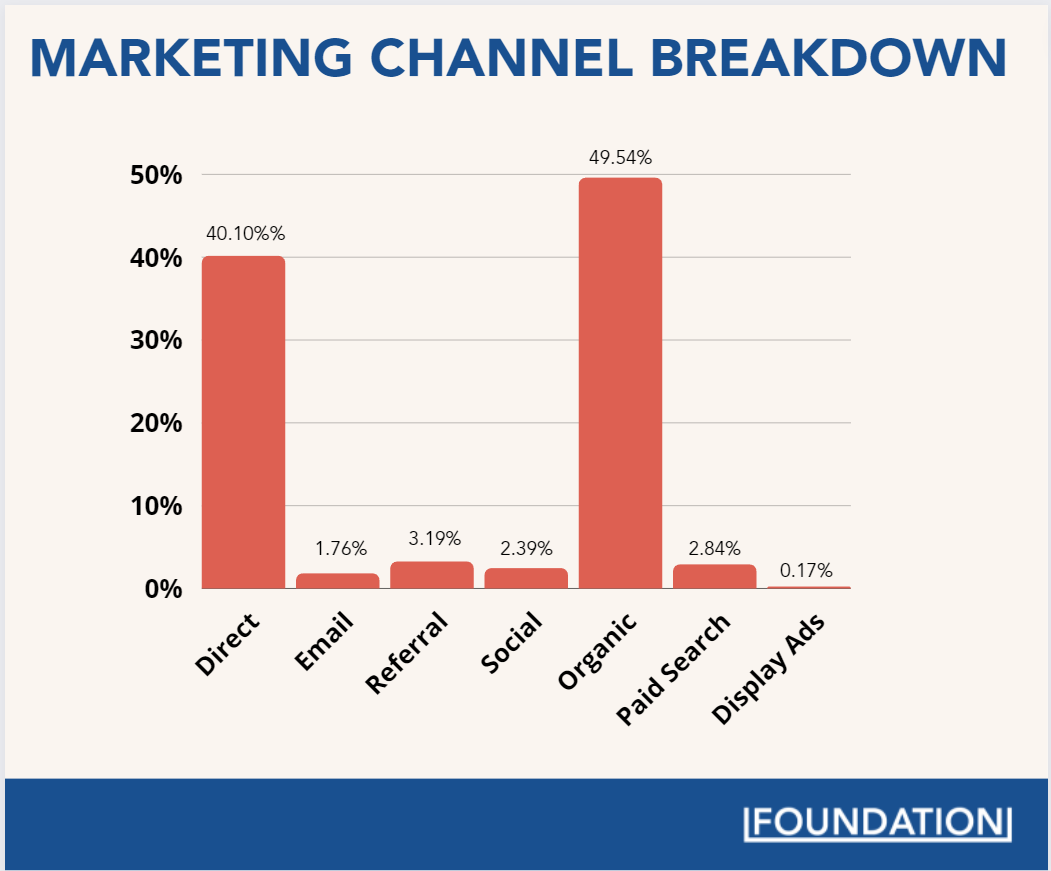
MongoDB’s extensive SEO moat is a huge part of that organic traffic.
Just take a look at their scorecard:
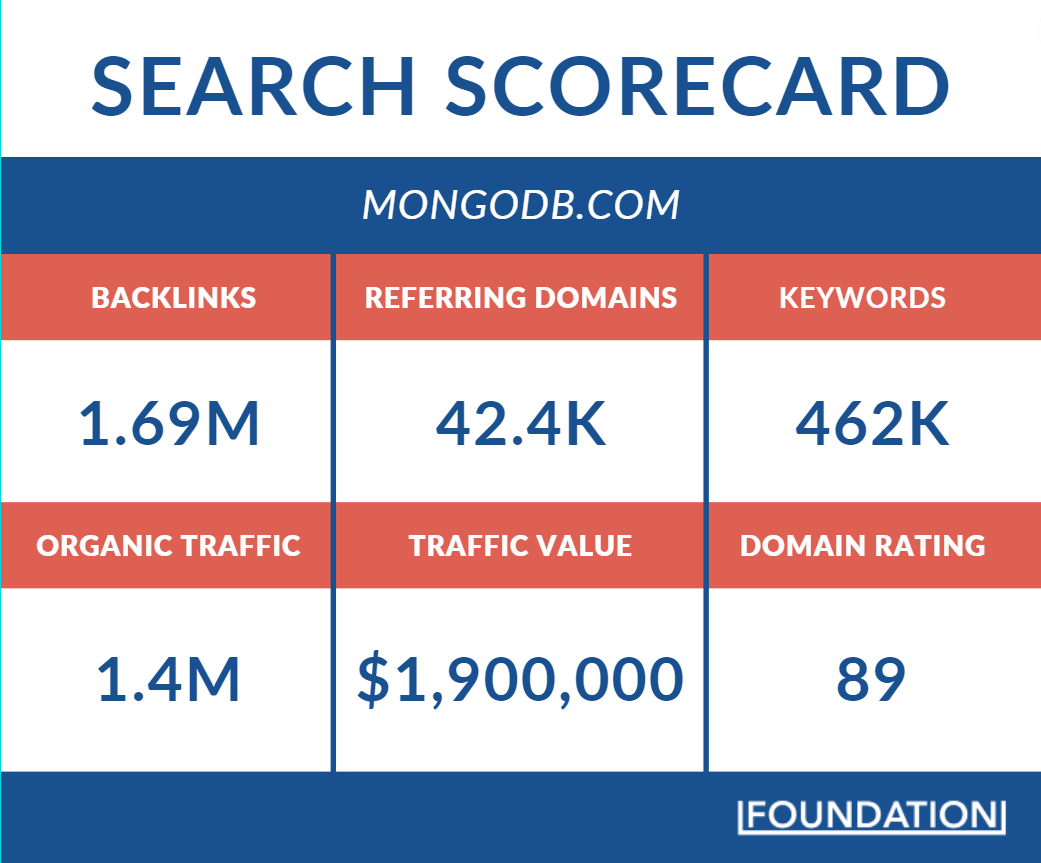
Over 462,000 organic keywords are driving millions of people to their site, traffic they’d need to spend $1.9M dollars to procure through paid ads.
In terms of search, about 75% of their hits come from branded keywords and phrases. This shouldn’t be a surprise considering they are the vanguard of the cloud database niche. Just like with Kleenex, Velcro, and Google, the company or product name is genericized — it becomes a noun. In our digital era, this means your product success becomes SEO success.
But MongoDB is even winning the battle for non-branded organic keywords.
Take a look at this:

That’s a lot of high-value SERP real estate. And it’s no surprise that these keywords garner such a high CPC, they’re dripping with purchase intent. They all deal with a highly technical topic that only very large organizations or very dedicated developers need to know.
Let’s look at one of their top pages: What is NoSQL?
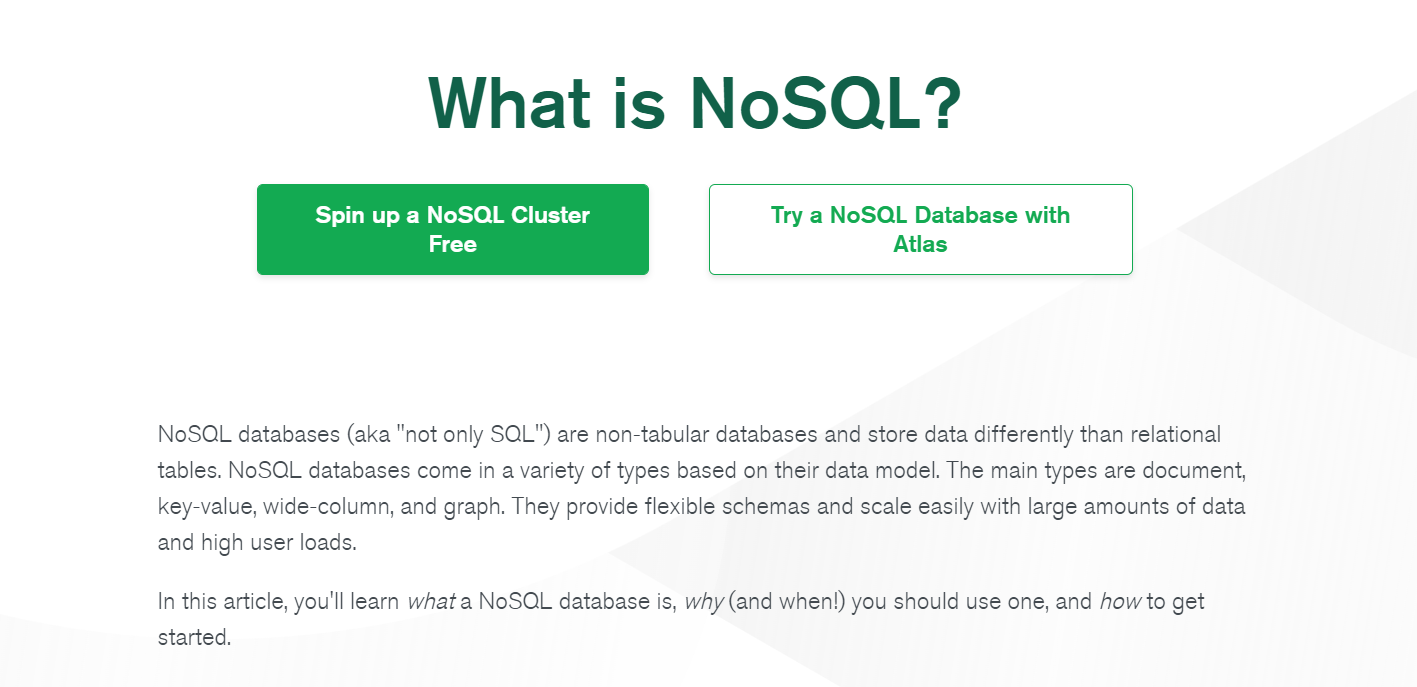
There are a few things to note straight off the bat:
- No bells and whistles – DevOps engineers and admin typically aren’t looking to be “wowed” by flashy headers and custom graphics. They’re dealing with extremely complex, mission-critical issues and don’t want to beat around the bush.
- Immediate CTA’s – You don’t get much more immediate than right under the title. Building off the last point, MongoDB knows that visitors on this page are looking for a non-relational database. The act of searching this out signals that the visitor is likely in need of MongoDB’s solutions.
- MongoDB knows its ideal customers – Notice the plurality. The first CTA addresses those very dedicated developers I mentioned earlier. The latter is for an organizational gatekeeper who is likely interested in the Atlas database-as-a-service offering.
From there, it’s back to your content marketing fundamentals.
Formatting that makes content skimmable and easy to digest:
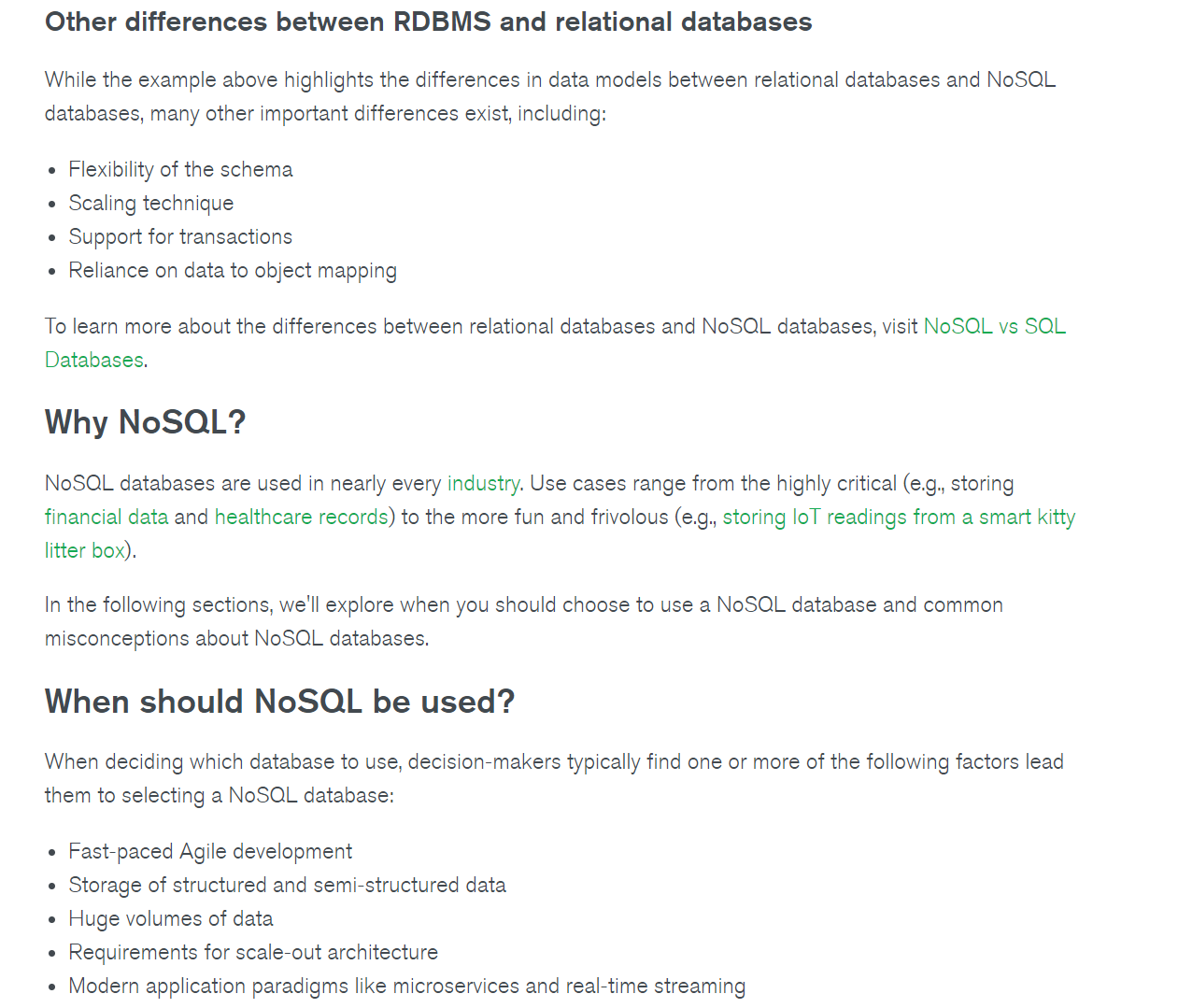
Screenshots of the MongoDB API in action:
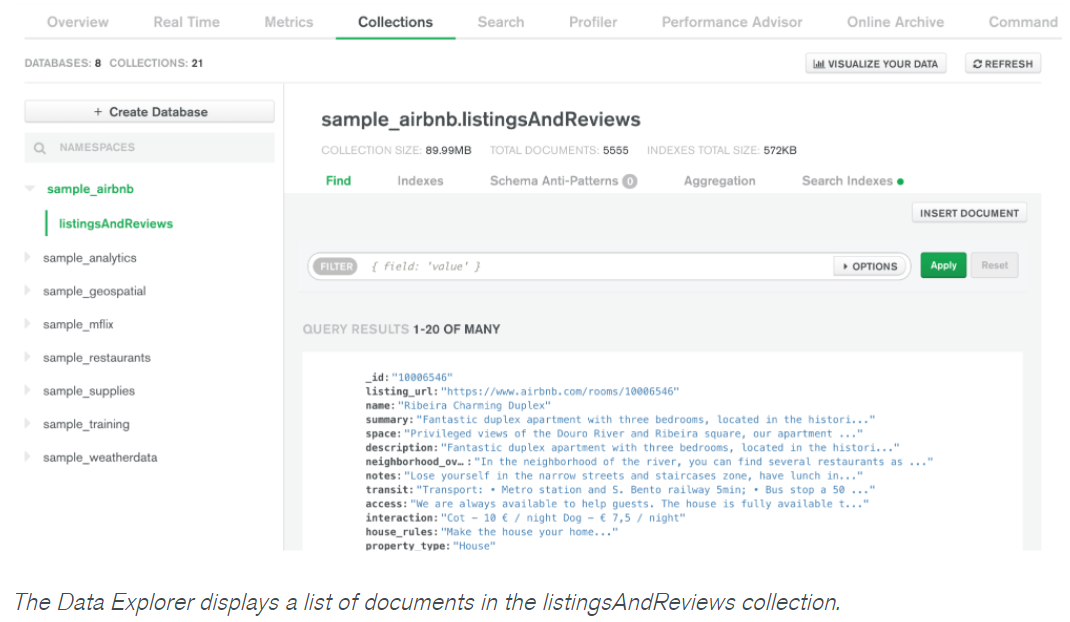
Ample internal links and CTAs to send visitors farther down the acquisition funnel:
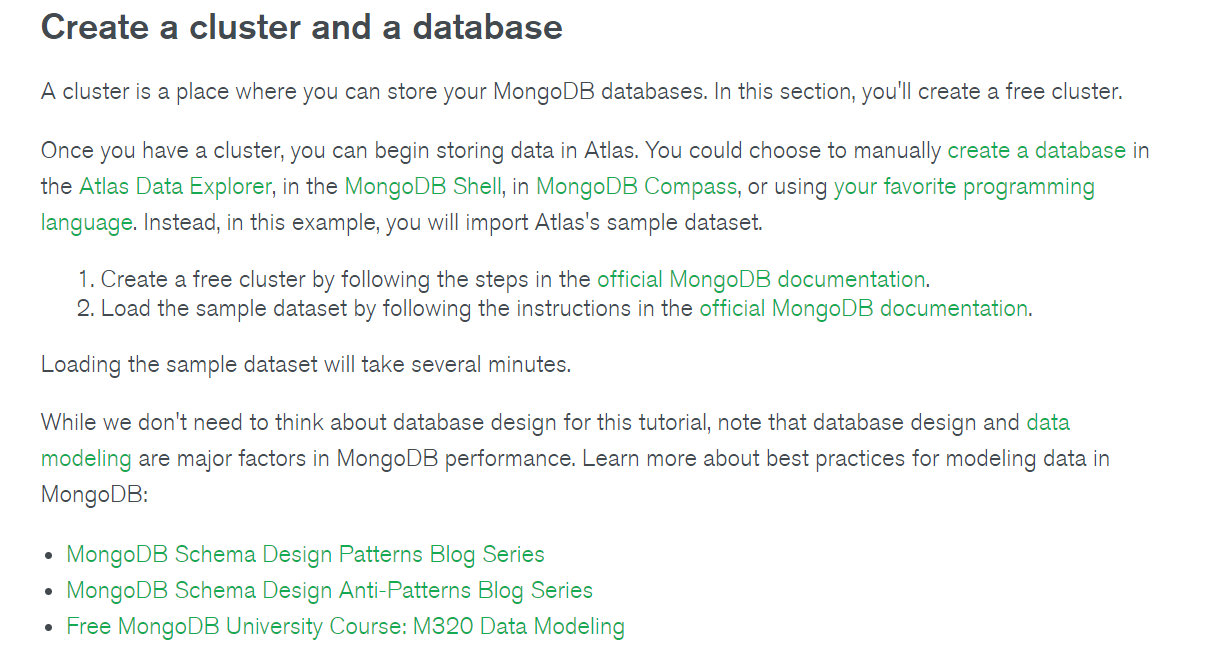
And the content marketing mastery doesn’t stop with the top-of-funnel content for organizational decision makers. MongoDB’s organic traffic is seeing a huge lift from developer-centric material. It’s the end-user era: start with the developers and the gatekeepers will follow.
API Documentation Goldmine
Ross Simmonds has said it before and we’ll say it again now — API documentation is a huge source of untapped potential for your B2B SaaS content engine.
Sure, it’s not the sexiest source content in the world, but who says you always need to take your content in that direction? Technical software necessitates technical documentation — don’t overthink it.
Case in point:
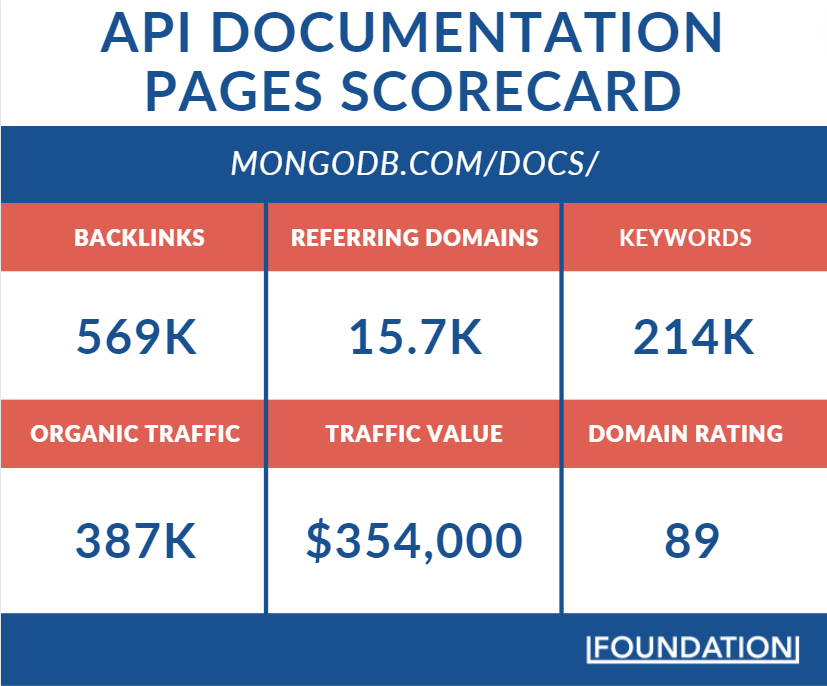
MongoDB’s own documentation hub is a cache of incredibly rich content — from both a content marketing and SEO perspective.
Again, the technical nature of programming documentation makes it a boring or intimidating topic for many content marketers. Who wants to spend time writing about database commands, server parameters, and thresholds when you can write about how your company is a key component of Fortnite’s success? Perfectly understandable. But it’s flawed logic.
The reference section alone is doing wonders for MongoDB’s SEO efforts.

And the best part? It’s not just keyword-stuffed ad copy. This content provides tons of value for members of the developer community. It’s also a great example of why UX matters just as much for content as it does for the product itself.
Here’s the page:
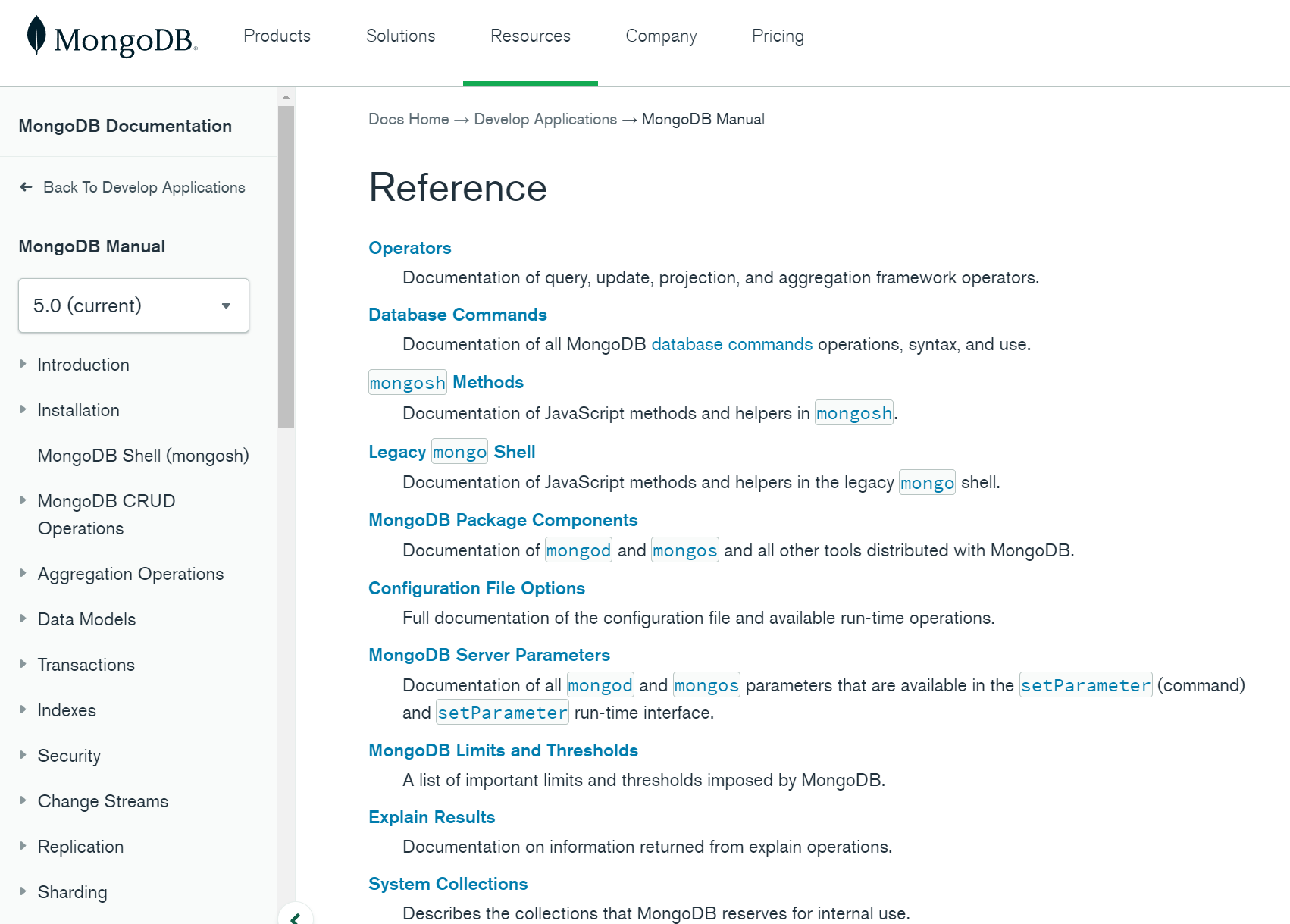
To the non-developers (myself included), this seems like a bit of a mess. But try looking again with your programmer hat on. The page is structured, clear, and full of information.
Here are a few of the highlights
- The reference page can be adjusted to reflect different versions of the MongoDB product, from the current 5.0 to upcoming to legacy.
- Code-specific keywords appear in the same font as they do in the MongoDB command line.
- A plethora of dropdown menus containing information about specific functions and features of MongoDB.
Now, it’s important to note that developer resources traditionally leave much to be desired. Large-scale surveys reveal that software developers are often frustrated by the out-dated, analog formatting of API documentation — a more interactive method is necessary.
This is where social media comes into play.
Creating a Thriving Social Network
As I showed you earlier, MongoDB is driving a significant amount of its traffic through organic and direct search. This isn’t surprising, considering the amount of developer resources they have on their website and the branded keyword effect.
But it takes more than these product-driven benefits to make a truly successful SaaS brand, one capable of taking on tech giants and established players with one hand and making deals with them with the other. There’s a key ingredient that still needs to be mixed in.
That ingredient is community.
Going Back to the B2B SaaS Well
Like all successful SaaS players, MongoDB is laying the foundation for growth through a broad community network.
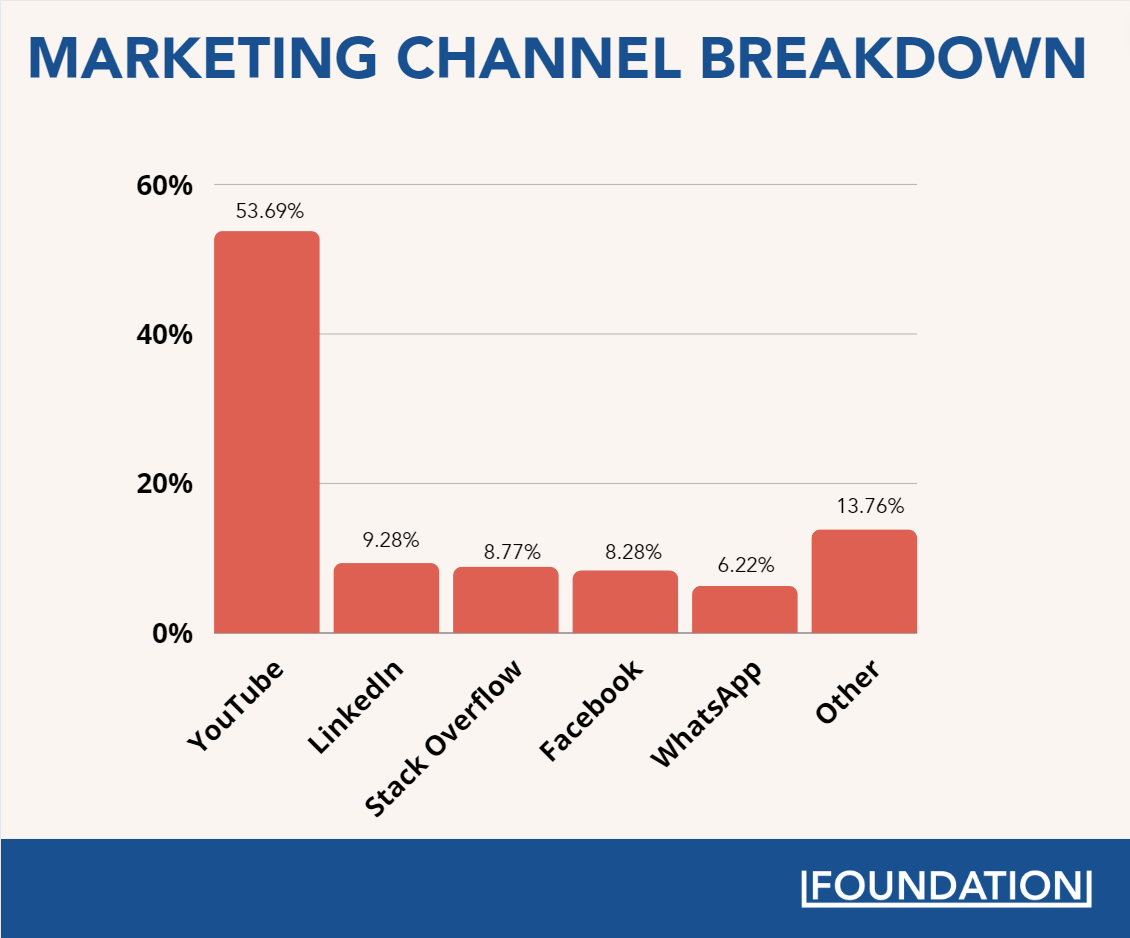
Now social traffic directs just over 2% of the 7 million visitors MongoDB sees each month, so you’re probably thinking “waste of time.” But I wouldn’t be so quick to judge — that’s over 90,000 people funneling from YouTube directly to the MongoDB website and about another 15,000 coming from LinkedIn.
The more mainstream social channels are clearly still useful, even for the most technical of SaaS companies. YouTube provides high-level product walkthroughs and LinkedIn communicates the benefits of MongoDB to upper management and the C-Suite.
But it’s what happens in Stack Overflow and the “other” category that really drives MongoDB’s community development.
Building Up a Loyal Developer Following
For any SaaS company relying on strong product-market fit for growth, it’s crucial that all efforts go into appeasing the end-user, which, in MongoDB’s case, is developers.
From a marketing and community-building standpoint, this means hitting these technical experts where they live (online, at least) and providing them with the right content. As Adam DuVander, author of Developer Marketing Does Not Exist, said to TechCrunch:
“[Every developer] has a few basic needs, like clear documentation, help getting started, and use cases to spark creativity.”
MongoDB certainly has the first two covered with their extensive documentation subfolder and community pages on their site. But the third case can be difficult for an “in-house” team to accomplish. Innovation and creativity occur in places that promote en-masse collaboration, and that can be hard to provide to pro-privacy communities like developers. At least, that’s how the old mantra goes.
But platforms like GitHub, Stack Overflow, and Twitch are around now, so there’s no excuse for SaaS brands to leave their end-users fragmented.
Here’s a look at their metrics for these developer platforms:
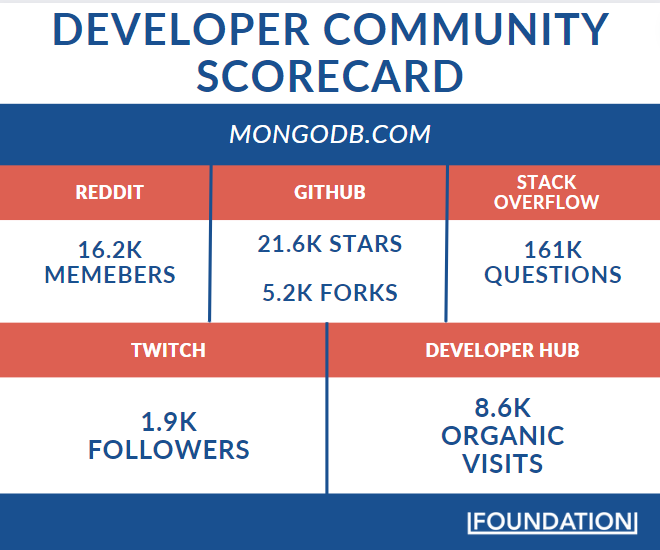
Each of these social channels gives developers a space where they can learn from experienced users, cut it up over their favorite features and use cases, and, most importantly, find that creative spark we talked about above.
GitHub has been particularly important to growing both MongoDB’s bottom line and developer community, with nearly 14% of all web referrals originating from there.
Twitch is particularly important when it comes to bringing the MongoDB brand into the mainstream.
One of MongoDB’s use cases is scalable database management for gaming companies. The company hit it big about 5 years ago, when they were managing data for the prize jewel of Epic Games: Fortnite. Unfortunately, a high-profile service outage soured that relationship (and MongoDB’s standing as a scalable database for the world’s most popular games).
But life goes on, and MongoDB has since been building out its following on Twitch. It could be a coincidence, but the fact that their channel features “Talk Shows & Podcasts” hosted by their Developer Relations team hints that they are committed to building community within the gaming world.
In the same way that partnerships with Goliaths like Amazon, Google, and Microsoft elevates MongoDB within the cloud infrastructure space, their partnerships with companies like SEGA, FaceIt, and Lucid Sight are doing the same in the gaming world.
“Giants Are Not What We Think They Are”
It’s important to note that Gladwell’s quote not only applies to the Amazons, Googles, and Microsofts of the world. In the grand scheme of things, MongoDB is the Goliath to a number of B2B SaaS companies. The point of these teardowns is to show that any B2B SaaS company can follow the footsteps of these giants — you just need to break them down into chunks.
In the case of MongoDB, the element of timing is certainly at play. The Cloud boom is just getting started in many respects, and MongoDB certainly has some lucky timing sprinkled on their fantastic product-market fit. But let that take nothing away from their success.
They’ve strategically hit all the sweet spots that highly technical SaaS companies need to win:
- Develop a fantastic product that is irresistible to the end-user and unmatched by competitors.
- Partner with the Goliaths that are too horizontally stretched to compete with you.
- Leverage their API-documentation and resource materials to achieve SEO dominance.
- Foster and maintain a strong developer community across your social channels.
If you’re still worried about the giants your team is facing, just remember: “The same qualities that appear to give them strength are often the sources of great weakness.”
Quick, do it now before the next drop!







